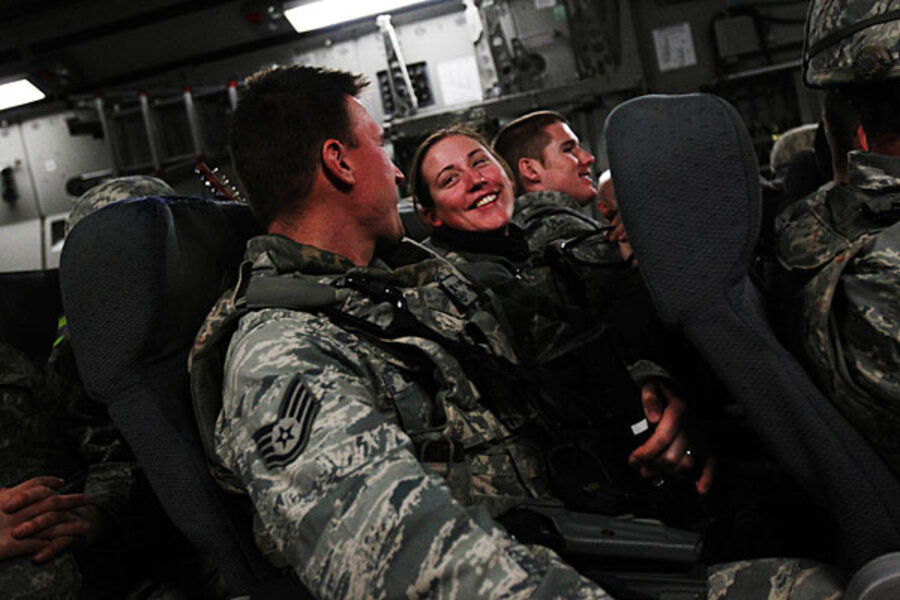Iraq war ends: what it was like on the last US flight out
Loading...
| TALLIL AIR BASE, IRAQ
On the US military’s last plane out of Iraq Saturday night, troops on board are in a festive, if slightly skeptical mood.
The Air Force crew manning the C-17 cargo plane has been told on previous missions that theirs will be the final flight out of the country in which America waged war for 8-1/2 years.
“They’ve said it was the last flight to us three or four times,” says Staff Sgt. Kristi Benton, reading a Dean Koonz novel.
But these had been false alarms, due to routine logistical swaps and tweaks.
Presently, however, the Air Force’s top noncommissioned officer in Iraq, Command Chief Master Sgt. Mike Hanning, boards the plane.
“I’ve been waiting for this day for a long time,” he says, settling into a jump seat.
As a pair of two-star generals appear as well – the highest-ranking Air Force commanders in Iraq – the crew begins to believe it: They will be the last airmen on the last American military flight of this war.
Maj. Gen. Anthony Rock, in charge of the Air Force’s training mission in Iraq, climbed to the cockpit to tell the captains the news. “They didn’t know,” he says.
When he informed them of this news, he adds, “They didn’t believe it.”
For General Rock and his longtime friend Maj. Gen. Russell Handy – the Air Force’s top officer in Iraq – the flight is both somewhat surreal and professionally profound.
It marks a poignant final chapter in a conflict that has spanned more than two decades of their careers.
As young captains in 1990, Rock and General Handy were in fighter squadrons in Langley, Va., with the mission of bombing this air base during the first Gulf war.
Handy, for his part, recalls the “pesky SAM or two” – surface-to-air missiles – that Iraq “had in this area literally for years.”
Adds Rock, “We were sure Saddam’s forces were coming.”
In their most recent assignments, Handy and Rock have instead been shepherding the Iraqi Air Force, training them to defend their country from external threats – and to safely land aircraft. (After the last US airmen climbed out of the air-traffic-control tower and on to the awaiting C-17 Saturday night, it will be an Iraqi air-traffic controller who will guide the US plane for its takeoff.)
“It’s a 21 year story,” says Handy, “all culminating in this operation.”
Before the troops begin boarding the flight, Handy urges them all to take a moment and soak in the momentous occasion – the rare and welcome chance to witness a war’s end.
“What I encourage you to do is look around,” he says. Think back “on the hundreds of thousands who have come before you. They’ve been counting on us to bring this thing to an effective close – to a proud close,” he adds.
“Just reflect a little bit on that.”
Air Force Tech Sgt. Wesley Wooden, who helped instruct Iraqi security forces in this, his fifth deployment to Iraq, does just that.
He first deployed to Iraq in 2003, and “camped out for almost a month” in the area where this base now stands.
In a few days he will be back in Cheyenne, Wyo., reunited with his wife and three children.
“This is coming full circle for me,” he says, adding that he believes for this base, at least, “We’re leaving it a lot better than we found it.”
US forces here have left behind office supplies, air-conditioning units, exercise equipment – "anything that would genuinely help the Iraqis’ quality of life,” Sergeant Wooden says.
Troops are also leaving behind pool tables, flat-screen televisions, XBoxes, and even signed autographed photos of some bands – think Queensryche – that had come through on previous USO tours.
As they prepare to leave, some airmen grab boxes of chocolate milk out of a full, still-humming cooler, which troops will also leave behind.
Wooden takes a look around the room. “As soon as we’re gone, this place is going to be flooded” with Iraqis who will want to survey what they’ve inherited, he says.
At about 9 p.m., word comes to the airmen to grab their duffel bags and head to the plane.
Sergeant Hanning urges them toward the flight, as he shakes hands and slaps the backs of the last of the gear-laden US military security forces and cargo specialists – who load their own bags and keep guard over the last of their comrades walking single file towards the runway – before hopping on the plane themselves.
“Let’s get this thing loaded up,” Hanning says. “You don’t have to go home, but you can’t stay here.”





